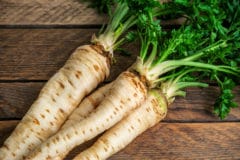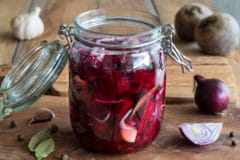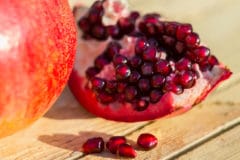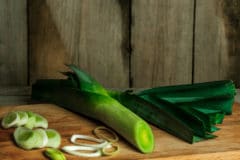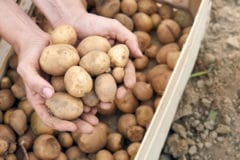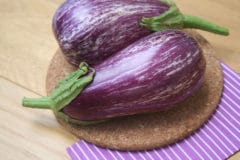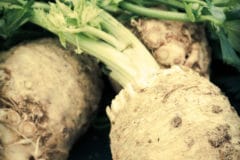A Head Start
Parsnips that are properly grown will store better. Always use fresh seed. The soil should be deep and loose, with a pH of 6.0 to 7.0; add lime if necessary. Although plenty of humus is important, manure can be too high in nitrogen, which causes roots to split or fork. Use well-rotted organic compost and leaf mold instead. Water to keep soil moist but not soggy.
Parsnip Varieties
Parsnips are available in several varieties; they may be hybrids or open-pollinated. Most are white and about 10-12 inches long, although a few are more broad and bulbous. Maturity dates vary but are all over 105 days.
- All American
- Andover
- Avon Resistor
- Cobham Improved
- Gladiator
- Harris Model
- Hollow Crown
- Javelin
Harvesting and Storage
As with growing conditions, proper harvesting promotes better storage. Parsnips taste best if allowed to remain in the garden through two or three hard frosts – this makes them sweeter. Very large parsnips may be tough and woody. Dig roots carefully to avoid damaging the root. Brush off soil, but don’t wash as it may increase the risk of rot.
Refrigerator Storage
The refrigerator is a good choice for short-term storage of a few parsnips. Don’t wash the roots, but do cut off the leafy tops about one inch from the roots. Wrap in a damp paper towel, place in a plastic bag and store in the crisper drawer of the refrigerator. The parsnips should be good for a couple of weeks.
Fermented Parsnips
To ferment parsnips, cut in julienne strips or ¼ inch slices. It is not necessary to peel them. You may add condiments such as red pepper flakes or ginger and other root vegetables such as carrots. Pack firmly in glass jars, then pour a salt brine solution over the parsnips and cover the jar. Let stand at room temperature two to three weeks and then store in the refrigerator.
Freezing Parsnips
Parsnips may be frozen as cubes or as a puree. Cut the roots into ½ inch cubes. Parboil or steam for about three to five minutes. If boiled, drain off the water. Cool quickly by blanching in ice water, pack tightly into containers, remove all air if possible and freeze. Parsnip puree should be fully cooked, pureed in a food processor and well cooled before freezing. Frozen parsnips will keep about 10 months.
Dehydrating
Like many vegetables, parsnips can be dehydrated. They can be salted or spiced and eaten as vegetable chips or added to soups and stews. Wash the parsnips, slice as thinly as possible and dehydrate until crisp (they’ll snap when bent, like a potato chip). Store in tightly sealed plastic bags or glass jars to keep them dry.
The Root Cellar
Parsnips also store well in a root cellar between 32 to 40°F (0 to 4°C) and 95% relative humidity. Cut off the tops prior to storing the roots, but don’t wash roots. Just brush off loose dry soil. Store in wooden boxes filled with damp sand, sawdust or peat moss for insulation. Keep away from apples or pears – they give off gases that make parsnips bitter.
Garden Storage
Except in very cold areas, parsnips can be stored right in the garden. The soil temperature should be kept between 35 and 40°F (2 and 4°C). A mulch of leaves, straw or hay 12 inches thick provides good insulation. The mulch should cover the rows plus 18 inches on either side. Harvest any time before new growth starts in spring.
Using Your Stored Parsnips
Fermented parsnips can be added to salads, soups and stews. Frozen cubed parsnips are also good in soups and stews. Frozen pureed parsnips can be mixed with or substituted for mashed potatoes – add butter, salt and cream to the hot puree. Parsnips from the root cellar or garden are sweet and nutty when roasted or slowly sauteed with olive oil, garlic and other root vegetables.

